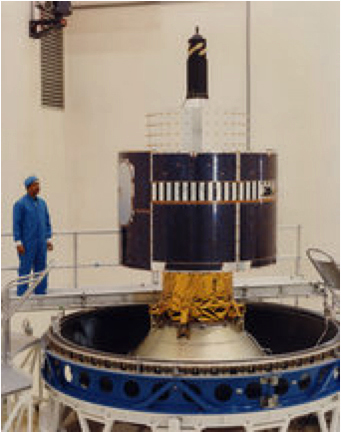[Satnews] On Friday, 1 December 1995, EUMETSAT formally took over the operations of Meteosat satellites from ESA's European Operations Control Centre (ESOC).
The handover was marked by a ceremony held in the then new headquarters of EUMETSAT in Darmstadt with ESA Director General Jean-Marie Luton, the chairman of the EUMETSAT Council, Jorma Riissanen, EUMETSAT Director-General Tillmann Mohr, and ESA's Director of Operations, Félix García Castañer. By the end of November 1995, there were two Meteosat spacecraft in operation: Meteosat-5 and Meteosat-6. The two previous satellites in the series, Meteosat-3 and Meteosat-4, were removed from geostationary orbit early in November 1995, having come to the end of their operational working lives.

METEOSAT-6. Photo courtesy of ESA.
The transfer of operations to EUMETSAT was carefully managed between the two centers over a number of months to achieve a trouble-free transition in the service for the end-users. The routine operations team was established in parallel with the development and integration of the new ground segment. The new EUMETSAT team was given intensive in-house training on the system throughout the summer so it was fully up to speed on the new systems and ready to take over on the day. Control of the Meteosat satellites in orbit was actually passed to EUMETSAT on 15 November 1995, with ESOC on standby until 1 December (before then, EUMETSAT contracted ESOC to control the Meteosat satellites). On the morning of, Wednesday, 15 November, there was a real sense of excitement and the realization that this was a truly historic day. Not everyone expected the EUMETSAT system to be fully operational from day one, but there was a huge sense of relief and pride when everything went according to plan and the system proved to be very reliable and robust.
The new EUMETSAT Meteosat Transition Program (MTP) system was considered one of the most advanced meteorological satellite ground systems in the world at the time. It is a testament to its initial design that the system is still running today. Many of the people who worked at ESOC and EUMETSAT at the time of the transition are still working at EUMETSAT, ensuring the flow of knowledge into the future EUMETSAT operational programs. These include not only the operations of Meteosat-8, -9 and -10 over Europe and Africa and Meteosat-7 over the Indian Ocean, but also of two Metop polar-orbiting satellites as part of the Initial Joint Polar System (IJPS) shared with the US National Oceanic and Atmospheric Administration (NOAA).
In addition to these spacecraft, the MSG-4 satellite, launched on July 16, 2015, is being commissioned before being placed into in-orbit storage and EUMETSAT is a partner in the Jason ocean altimetry missions operated jointly with NOAA, NASA and CNES. From 2016 onwards, EUMETSAT will operate the Copernicus Sentinel-3 marine mission in cooperation with ESA and on behalf of the EU, and deliver data services to the Copernicus Marine Environment Monitoring Service and the Copernicus Atmosphere Monitoring Service.
The data and products from EUMETSAT’s satellites are vital to weather forecasting and make a significant contribution to the monitoring of environment and climate change.


